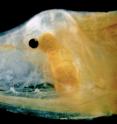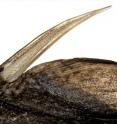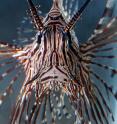Researchers tally huge number of venomous fishes, tout potential for medical therapies
Upon hearing the word "venom," most people probably think of a snake's fang. But the ability to produce and inject toxins into another animal is so useful, it has evolved multiple times in creatures ranging from jellyfishes to spiders, shrews to the male platypus.
Now, a paper appearing this week in the journal Integrative and Comparative Biology catalogs instances of venomous aquatic life, for the first time showing that venom has evolved 18 separate times in fresh and saltwater fishes.
Among the paper's other findings:
In contrast to squamates like lizards and snakes, very few fishes have evolved venomous fangs or teeth
The predominant function for venom in fishes is defense rather than offense
Venom in freshwater is dominated by catfishes, as opposed to marine environments where it is widespread across many groups
It is surprising how comparatively common venom is in deep-sea sharks (30 percent of venomous sharks) compared to deep-sea bony fishes (5 percent of venomous bony fishes)
"For the first time ever, we looked at the evolution of venom across all fishes," said lead author William Leo Smith, assistant curator at the University of Kansas Biodiversity Institute. "Nobody had attempted to look across all fishes. Nobody had done sharks or included eels. Nobody had looked at them all and included all fishes in an evolutionary tree at the same time."
Smith and his KU co-authors Jennifer Stern and Matthew Girard, along with Matthew Davis of St. Cloud State University, spent years combing medical reports of people exposed to venom from fishes. Then the team assembled the family trees for those fish, using specimens from natural history museums to trace evidence of venom through closely related species.
"We figured out what a venom gland looks like in a known-venomous animal and what it looks like in all related groups," the KU researcher said. "For instance, relatives of yellowtail that people eat as sushi were reported as venomous, and we were able to find venom glands in their spines."
According to Smith, the 18 independent evolutions of venom each pose an opportunity for drug makers to derive therapies for a host of human ailments.
"Fish venoms are often super complicated, big molecules that have big impact," he said. "Venom can have impacts on blood pressure, cause local necrosis, breakdown of tissue and blood, and hemolytic activity -- it prevents clotting to spread venom around prey. Venom is a neurotoxin. The average response is incredible pain and swelling."
According to Smith, because fishes have to live with their own venom, "there might be helper molecules that protect the fishes themselves and help them survive." He said these also could have therapeutic value to people.
Smith said that up to 95 percent of venomous fish use their toxins defensively, usually gathering venom within their dorsal spines, where it can be deployed in case the fish is crushed or another fish attempts to swallow it.
Some, however, use venom offensively to debilitate their prey and can sometimes injure people.
"Invasive lionfishes will orient themselves in a strange way and ram themselves at people," Smith said. "One-jawed eels have lost the upper jaw, but with the lower one they slam prey up into a modified fang. Their venom gland sits right above the brain."
Smith studies biological traits -- like the ability to make venom, fly or produce light -- that have evolved separately in different lines of species. He said venom is distinct from poison because it typically won't harm an organism ingesting it; venom works when it comes into contact externally, something Smith himself has experienced when working in the pet trade (where most venom U.S. exposure occurs), cleaning his own fish tank or collecting fishes during fieldwork.
"I've never been offensively stung," Smith said. "The problem is they hide in the rocks in your fish tank, and you move the rocks. Or, when you're collecting fishes. You're out there in the water with a mesh bag and a spear, trying to get venomous things, and then a wave hits you and drives the bag of spines into your chest, and you say, 'Ah I regret that.'"
Source: University of Kansas
Other sources
- Study: Venomous fish could be repository of medicinal compoundsfrom UPITue, 5 Jul 2016, 21:31:01 UTC
- Researchers tally huge number of venomous fishes, tout potential for medical therapiesfrom Science DailyTue, 5 Jul 2016, 20:31:10 UTC
- Researchers tally huge number of venomous fishes, tout potential for medical therapiesfrom PhysorgTue, 5 Jul 2016, 19:31:30 UTC
- Venomous fishes could provide medical therapiesfrom Science BlogTue, 5 Jul 2016, 19:31:25 UTC


